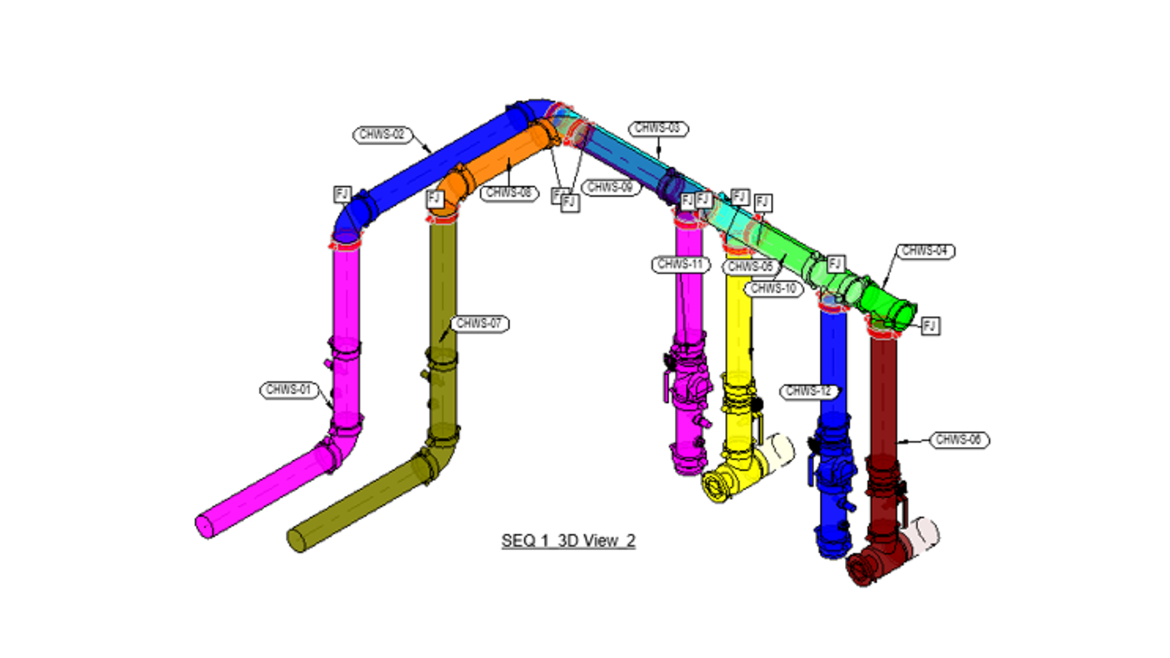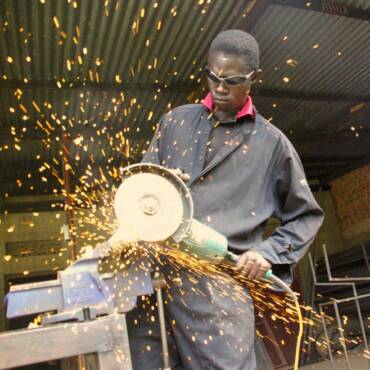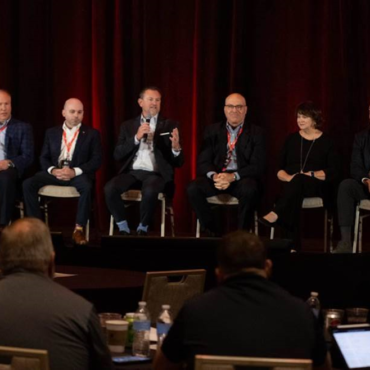Findings from FMI’s 2023 Labor Productivity Study suggest that prefabrication is taking an increasingly important role in advancing construction projects. With mechanical, electrical and plumbing (MEP) contractors comprising 59% of the participant pool, FMI’s report offers an interesting glimpse into the future of the HVACR industry. According to the study, participants expect 34% of their craft labor hours will be dedicated to prefabrication by 2028 — double the time they currently allocate to the construction methodology.
Prefabrication can offer significant advantages on a jobsite, and its growing adoption rate across the industry is proof of that. It helps field crews work faster on-site by giving them a “head start” on complex pipe assembly, slashing schedules and enabling faster system deployment. Assembling joints in a controlled environment can also enhance quality control as mechanical contractors don’t have to navigate site challenges, like maneuvering between tight spaces, to connect piping components one by one.
But as the prefabrication process adds one more specialist to the team roster — the fabrication shop — effective communication and coordination are elevated from crucial to mission-critical for project success.
Three ways to improve real-time communication with interdisciplinary teams
Prefabrication enables field teams to install mechanical spaces in a fraction of the time compared to traditional building methods. However, the time and cost savings contractors gain by using prefab methods can quickly evaporate when there are communication gaps between design, fabrication and field teams.
Construction teams need to establish strong lines of communication to prevent oversights and confusion that could derail complex piping projects. We’ll discuss three solutions to eliminate communication gaps across the project lifecycle.
1. Digitize project information for real-time decision-making
Construction projects are information-rich, but manual data tracking can add unnecessary risk to projects with multiple stakeholders and geographically dispersed teams. Inputting information into spreadsheets is an improvement on the traditional whiteboard approach used by many disciplines; however, it doesn’t quite achieve the real-time communication teams need to work efficiently.
Think of the domino effect that a single production deviation can trigger. If the fab shop is delayed in fulfilling a modular skid order but can’t get in contact with the jobsite to inform them before the end of the day, contractors may spend the next morning waiting for a shipment that won’t arrive until the following day. How much productivity is lost in the time it takes to track down the skid?
Digitizing and automating production status updates from the fab shop allows field teams to plan their daily schedules and resources better. For example, suppose a project manager can see digitally that the 3” pipe spools for the mechanical room boiler will be fabricated and shipped before the 30” large-diameter cooling tower spools. In that case, the PM may decide to use a smaller crew to reduce downtime at their site on Wednesday, sending those extra laborers to a different project jobsite where the extra hands can make a greater difference.
2. Capture detailed notes throughout the supply chain
Mechanical piping components exchange hands multiple times throughout the supply chain and prefabrication process before reaching their final destinations as pipe spools, which can cause major headaches when there are quality issues.
Did the imperfection originate at a fabrication cell with equipment that needs replacement? Or were pipe spools damaged when offloading the shipment at the jobsite? Could they have been mishandled during installation?
Quality control measures should be taken at each touchpoint throughout the spool’s journey along the supply chain. Requiring pictures and field notes of material conditions at each step of the journey allows project teams to seamlessly build documentation they can reference to quickly identify and rectify issues. Without these reference points, an entire fabrication shop may need to pause production to fit reworking pipe spools into the schedule, ultimately delaying other project needs. Simultaneously, field teams may need to readjust their workforce or schedules in response to delays.
3. Opt for BIM solutions that integrate with multiple disciplines
MEP engineers work diligently to create accurate mechanical drawings, models and bills of materials that fab teams use as a guide to deliver required components. Still, you’ll rarely find a project that doesn’t experience at least one change order. As designs evolve, field and fab teams need to have the most recent information available to proactively adjust their workflows and avoid unnecessary rework.
For example, if designers update Revit models to add 1” of pipe length to a system based on field team reports of actual site conditions, fabrication teams will need to adjust their cut lengths. If this change isn’t communicated and coordinated in real-time, the fab shop may need to pause production lines to rework spools that were completed just a couple hours earlier.
Often, different disciplines have their own tools and processes for managing their workflows. To help break down silos and encourage smooth collaboration, consider using software or add-on solutions that integrate BIM and fabrication processes.
Selecting the right MEP software
There are a variety of MEP fabrication and construction software solutions in the market designed to support cross-team collaboration in increasingly complex scopes and decentralized working environments. When evaluating different solutions, such as the Victaulic SpoolTracker App, PARASCADD AUTOSPOOL, GTP Services’ STRATUS, and McKinstry MSUITE, consider the following questions:
- How well does the tool integrate with the major software used by the disciplines on your projects, including design, fabrication and field installation?
- What project details can you track?
- Does the provider offer automation features to streamline workflows? If so, what level of customization do they offer?
- Is the software limited to use on a computer? Is there a mobile option?
- Does the software work offline in the fab shop and jobsite?
Efficient communication is crucial to rapid system deployment, quality control and risk reduction in mechanical projects. The MEP software your team uses will directly influence its workflows and communication channels. Before making a purchase decision, it’s important to consider how the tool will bridge existing communication gaps to facilitate project success from the fab shop to the jobsite.
Whether you require installation, repair, or maintenance, our technicians will assist you with top-quality service at any time of the day or night. Take comfort in knowing your indoor air quality is the best it can be with MOE heating & cooling services Ontario's solution for heating, air conditioning, and ventilation that’s cooler than the rest.
Contact us to schedule a visit. Our qualified team of technicians, are always ready to help you and guide you for heating and cooling issues. Weather you want to replace an old furnace or install a brand new air conditioner, we are here to help you. Our main office is at Kitchener but we can service most of Ontario's cities
Source link




Add Comment